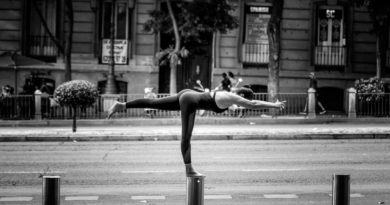Breath as Prana
1.34 pracchardana vidharana bhyamva pranasva
Or through the measured exhalation and retention of breath.
What is prana?
The etymological root of the word prana comes from pra- pro, forward, proud and an- animal, untethered. Prana is often defined as breathe, but prana is the ultimate source of all activity in the universe. Within the physical body there are five primary forms of prana. The movement of these forms of prana becomes more refined as the tensions of the physical body are unwound through the practice of vinyasas that are in harmony with the flow of prana and in sync with the environment. This happens when we work with these five forms of vayu that flow within. These vital winds and their balanced movement are cultivated through the proper intake of food and the practice of yoga.
Prana is cultivated and built through the sensations, sounds, images and feelings that we come into contact with during our daily practices. The sense organs are the roots of the mind and their inputs allow the mind to ground experience and focus our energy.
We tend to focus our prana on activities that benefit our minds, but sometimes the activities of daily life can confuse our attention and uproot us from our connection to prana. In order to re-establish our connection to prana we begin to cultivate sensitivity in our asana practice noticing how our sense organs respond to the postures, breath and mind.
Eventually our experience of prana becomes so vivid that we can follow the prana into the subtler layers of our being. This experience of the subtle layers confirms the understanding that the physical body is an expression of underlying energies such as our emotions. Emotions strongly affect the ability of prana to move within the physical body. When we experience emotions associated with dis-satisfaction then we injure the prana and lose the liberating wisdom for our journey.
- Fear can cause prana to sink and hibernate
- Anxiety fragments it
- anger makes it rise and expand with intensity
- Grief contracts it
- Joy dissipates it
By noticing our emotions and how they affect prana in our system then we can begin to work towards embodying our prana. When this is achieved we experience balanced activity through intuition and subtle sensitivity. Through prolonged practice with devotion we can bring the theoretical practice of yoga into our body and it becomes insight in action.
“Practice of asanas, khumbaka’s, and karana’s until the fruit of Raja Yoga is won.” HYP, 1.67
Khumbaka
Khumbaka is translated as the retention of air. This happens naturally in the pause between the inhale and exhale. Through the intelligent asana the goal is to balance engagement and relaxation on the physical level. On the energetic level the cultivation of the khumbaka stills the breath and then the mind. This allows our mind to become silent and witness the movements of prana within. When the breathes depth and rhythm are augmented prana flows in new ways.
In the beginning of yoga practice a simple form of ujjayi with a gentle khumbaka is recommended. This lengthens the breath and standardizes the inhale and the exhale. Although it is rudimentary it initiates the Valsalva effect and changes our experience of perceptions allowing time to stand still and the subtle effects of postures to be recognized.
Asana sthiti refers to the khumbaka done in coordination with an asana. There are both internal and external types of khumbaka but both of them are used in order to still the internal winds within the body. Prior to asana sthiti vinyasa is used to establish the breath rhythm and skillful activation of the bandhas set the stage for khumbaka. These are advanced subjects beyond my understanding. The stilling of the winds allows the flame of awareness to become steady and shine its pure light.
Ujjayi breathing
The simple form of Ujjayi requires a slight narrowing of the base of the throat where the collar bones meet. It is also important to have engagement of the three bandhas for true Ujjayi. There is a gentle hissing sound that arises within the chest and behind the heart. The breath does not need to be forced and if tension is being accumulated in the jaw or back of the throat this hinders the cultivation of dharana which is the first stage of meditation.
Karana
A karana is a dynamic position in which the hands and feet are coordinated. The movements wake up the vayus. A linear, circular or spiral movement will break down peripheral tensions in the srotamsi and are the preparatory movements that can be used to facilitate the internalized and centralized action of seated postures. Meditation can be performed in any seat and is the ultimate goal of all the seated postures. If dynamic activity is not balanced with stillness then the practice of yoga creates vata leading to stiffness and muscle tension instead of cultivating prana.
Slow rhythmic movements in the form of karana are the primary tools to merge sthiti (static) and ghati (dynamic) movements that represent the universal duality such as stillness and motion. This sets the stage for pranayama
Pranayama
The practice of yoga is divided into external practices and internal practices. The external practice takes place in the annamayakosha (food sheath) and encompasses the limbs of yama, niyama and asana. The internal practice takes place in the manomayakosha, vignanamayakosha and anandamayakosha and encompasses the limbs of pratyahara, dharana, dhyana and Samadhi.
Pranayama is the axis between these two practices. Prana itself is the bridge between consciousness and the material world and so its movement determines states of spiritual enfoldment.
There are four phases of the breath:
- Inhalation
- Exhalation
- Inhale retention
- Exhale retention
The practice of asana and pranayama varies the ratios and rhythms until the breath finds an internal circuit and no longer leaves the body. This happens when two of the five vayus come into harmony. These are the expansive, warm, productive exhalation of pranavayu and the internal, cool, restorative inhalation of apana. The union of these two forces is the ultimate expression of the practice of hatha yoga.
“Prana is the day and it moves upward through the solar channel like the sun through the right nostril. Apana is the night and it moves downward through the lunar channel.” Kalottara Tantra
Prana is taken in through the sense organs. The type and quality of the prana is shown in the following table describing the sense organs and the organs of action.

The study of the breath can take you deep into the practice of yoga and no words are a substitute for an experienced teacher who can guide you down this process. Hopefully these words may inspire you to go deeper into your practice and find a mentor who can guide you.




